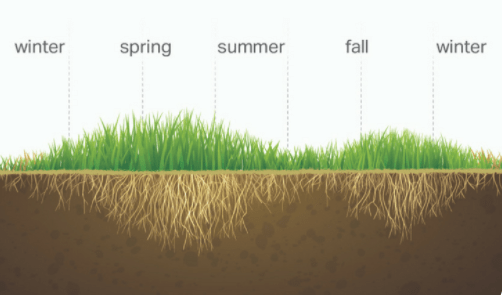Plants know when adverse weather changes are approaching. To prepare their soft tissues for freezing temperatures, drought, or a shortage of nutrients, plants will go into dormancy.
In this state, most physiological processes get suspended or slowed down to conserve energy until when things turn back to normal.
Like any other plants, lawn grasses also prepare for the upcoming hot or cold weather conditions. In the fall (Late October or early November) when daytime temperatures drop below 50°F your grass will stop growing.
When overwintering, grass will remain in a dormant state until early spring when the soil becomes warm.
In winter, water freezes and becomes scarce, and the snow covering the ground prevents light and air from reaching the grass blades and roots. The dipping temperatures and insufficient sunlight decelerate plant metabolism thus halting any growth.
However, for some plants, the growth of roots in the soil continues during this period of rest.
Similarly, in drought, plants stop growing due to lack of water, which is a very essential element for any plant cell activities including photosynthesis – the process by which green plants and some organisms use sunlight to manufacture food from water and carbon dioxide.

Things to do in the fall before Frost
As a gardener, there are a number of things you should do to help your lawn overwinter greatly so that you can wake up to green lush grass when spring comes.
1. Feed your Grass
A winter fertilizer is highly recommended for cool-season grasses which include fescue, Kentucky bluegrass, and perennial ryegrass. These grass types thrive in cooler weather thus applying a winter fertilizer in late fall (Late November) will help in strengthening the grass and make it survive in freezing temperatures.
Do not apply a winter fertilizer on warm-season grasses which include Bermuda, centipede, St. Augustine, and zoysia. These types of turf turn brown and dormant when frost hits and will not benefit from any winter nourishment. Spring is the best time to apply a strong feed on your warm-season grass.
If you come from regions that don’t receive any frost during winter, a slow nitrogen release fertilizer before the 1st of September will help your warm season grass to remain fairly green throughout the cold period.
2. Mulch fall leaves
During fall, trees drop leaves to prepare for the cold weather ahead. Leaving leaves on your lawn will soothe your grass and attract fungus like snow mold. If you cannot, blow or rake, simply mow over the leaves to mulch them into your lawn.
The small pieces of leaves will decompose thus adding nutrients to the soil. After mulching leaves, feed your cool-season grass with a nitrogen winter fertilizer. A nitrogen feed not only makes grass greener but also speeds up the microbe’s action on the mulched leaves.
3. Mow grass shorter
In late fall before the first frost, mow your lawn 2 inches shorter than you have been doing in the rest of the seasons. Mowing grass right before winter helps in keeping grass healthy throughout the cold season. Removing grass blades prevents moldy fungus and damage caused by freezing temperatures.
4. Aerate your lawn
Fall lawn aeration enables water and nutrients to quickly reach the grass roots. Punching small holes in the turf helps in breaking up the hard and compacted soil. Depending on the nature of the soil, you can decide to do plug aeration using hollow tines or simply drive a spike into the soil to create a hole.
5. Reseed/overseed
Fall is a great time to repair bare spots in a lawn. Overseeding in early to late fall with annual ryegrass results in a thick dense lawn in winter for cool-season grass and in spring for warm-season grass. Ryegrass is a good option to use since it is cheap and grows faster.
6. Control weeds
Weed your lawn during fall to prevent the germination of weeds in spring. You can apply a pre-emergent herbicide or manually pull established weeds before they spread their seeds. When using an herbicide, be sure to read and follow label instructions on where and how to use it.
7. Winterize your lawn gear
Before freezing begins, be sure to winterize your lawn mower and sprinkler systems to prevent freeze damage. Clean and store your mower in a clean dry place ready for the next season.
Conclusion
A well-maintained lawn in fall will be acknowledged in spring as the grass sprout. If you did a good job, then expect a dense lush lawn without bare spots, snow mold, or weeds.